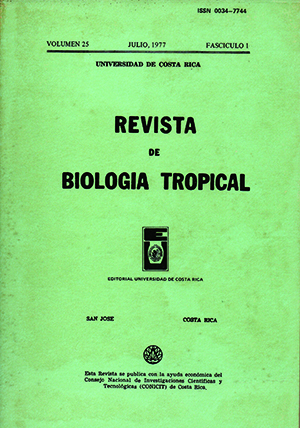Abstract
An ichthyological survey was made of the Lake Arenal, Rio Bebedero and Rio Tempisque drainages where respectively, 25, 22 and 21 species of fishes were collected. The study was urgent because a hydroelectric project will soon enlarge Lake Arenal and divert its waters to the Pacific slope for hydroelectric and irrigation purposes.
The altitudinal and geographic distribution of these icthyofaunas and pertinent ecologic variables were analysed. The species were classified according to their preferred current velocities, and aspects of temperature, type of substrate and size of river were also treated.
Current velocity and size of river appear to be most important in determining the upper altitudinal limits of some fishes. Lower altitudinal limits seem most influenced by water temperature and interspecific competition. Geographic distribution is most influenced by current velocity and the resulting effect on other parameters. Stenotopic species with spotty distributions are probably limited by the availability of suitable habitats. Some lowland species of the Tempisque and Bebedero drainages apparently cannot compete with the relatively divers ichthyofauna of these large drainage basins, but are common in depauperate coastal streams.
Two species, Neoheterandria umbratilis and Bryconamericus scleroparius are reported for the first time on the Pacific versant of Central America, and a new species of Rivulus was taken in the Arenal region and Bebedero headwaters. The two former species, as well as many others common to both versants, have reached the Pacific versant by crossing low altitud passes of the continental divide.
One collection from Arenal and another from the Tempisque basin, both of relatively high species diversity, come from waters of high biomass, productivity and habitat diversity.
We predict that the Arenal ichthyofauna in general will adapt to the new reservoir environment after an initial period of disequilibrium and suggest precaution in considering any future introductions of exotic fish species. The eventual passage of fish from Arenal to the Pacific versant should have no adverse effects.
References
Bussing, W.A. 1975. Utilidad de los recursos pesqueros nacionales. Rev. Univ. Costa Rica, 41: 17-21.
Bussing, W.A. 1976. Geographic distribution of the San Juan ichthyofauna of Central America with remarks on its origin and ecology, p. 157-175. In T.B. Thorson (ed.), Investigations of the ichthyofauna of Nicaraguan lakes. University of NebraSka Press, Lincoln.
Costa Rica. Instituto Costarricense de Electricidad 1974. Plantas y proyectos de generación eléctrica del Instituto Costarricense de Electricidad. I.C.E., Costa Rica. 12 p.
Ham, M.H. 1972. The amount of space available for marine and freshwater fishes. Fish. Bull. U. S., 70: 1295- 1297.
León, J. 1952. Nueva geografía de Costa R ica. Librería La Española, Costa Rica. 170 p.
U.S. AID Resources Inventory Center 1965. Amílisis regional de recursos físicos, Centroamérica y Panamá. A.I.D. Resources Center, Washington, D.C. Texto 33 p., láminas 33 p.
Comments

This work is licensed under a Creative Commons Attribution 4.0 International License.
Copyright (c) 1977 Revista de Biología Tropical


